
The top photograph is the first view of Blackwater gained when travelling westwards (Photo: Clive Benney)
Tony Mansell’s second article in this series places a magnifying glass over the village of Blackwater where he attended primary school, broke his leg in the playground and regularly “raided” the local shop for sweets on his long bicycle ride home at the end of the day.
Until the 1980s, Blackwater was a name familiar to most people travelling through Cornwall; it was on the main artery road, the A30, and it was difficult to avoid making use of it. Like many villages along this road it was by-passed and life there changed forever.
The original route was likely used by early man, occupying forces and by successive generations of travellers. Pilgrims heading westwards for the sanctuary of St Michael’s Mount passed this way and columns of rebellious Cornishmen must have marched along it as they sought to air their grievances with our lords and masters beyond the Tamar. Donkeys, steam wagons, horse drawn carriages, motorcars, buses, and coaches transporting both tourists and locals have graced it. It was the “beaten track” but now it has been by-passed and that distinction has moved a little to the south.
Access to the village is by one of four hills, three of which, to the east, north and west, sweep down into the village. The fourth slopes away from the village, to the south and takes you under the road by-pass and the 1850s main-line railway viaduct and on into the neighbouring village of Chacewater. So, with the ground on three sides being much higher it is fair to describe Blackwater as a southern facing village with protecting hills on three sides. Because of this, its surface water sheds to the south and finds its way into one of the tiny rivulets travelling in that general direction. The water in one of these streams was apparently very dark in colour and it is thought that the name of “Blackwater” may have arisen from this. Whatever the truth, the name is clearly English rather than Cornish and is likely to have been a replacement for an original name which is suggested as being Giew in Gimpe.
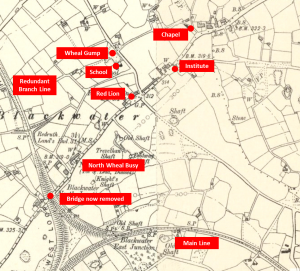 Blackwater and its main features (Plate: Tony Mansell)
Blackwater and its main features (Plate: Tony Mansell)
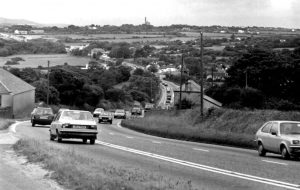 Blackwater hill, to the east, before the by-pass opened (Photo: Clive Benney)
Blackwater hill, to the east, before the by-pass opened (Photo: Clive Benney)
The village is the westernmost part of the ecclesiastical parish of Mithian and Kelly’s Directory(1) of 1873 describes it as partly in the civil parishes of St Agnes and Kenwyn and where the four hundreds of Powder, Pydar, Penwith and Kerrier meet. The “Gazetteer of Cornwall” in 1884 stated that it was “A village containing two inns, a Wesleyan chapel, several shops and a population of 150 persons”.
In past years, people travelled very little; the products and services needed were mostly available from within their community. Most people would have been born near-by and to find anyone from beyond Cornwall’s borders would have been unusual. Consequently, everyone knew each other and everything about them and if they didn’t then they usually made it their business to find out. Life revolved around the village institutions: the school, the chapel, the church, the pub and the shops. The standard of living was modest and times were hard but somehow people managed and there were many cases of large families being raised, sometimes by single parents.
 “Poddler’s Plosh” to the left and in the distance is the railway embankment and the bridge over the A30 road (Photo: Argall – courtesy Clive Benney with notes added by Tony Mansell)
“Poddler’s Plosh” to the left and in the distance is the railway embankment and the bridge over the A30 road (Photo: Argall – courtesy Clive Benney with notes added by Tony Mansell)
Blackwater was a mining community with a number of metalliferous mines either within or close by the village. North Wheal Busy was a copper mine, also known as “Blue Burrow” or “Poddler’s Plosh”. It was located between the Chacewater road leading from the centre of Blackwater and the old railway embankment. It was about 100 yards from the main road and was worked from Knight’s Shaft which was 220 yards north east by east of the Spread Eagle, a public house lost when the railway embankment was formed in 1902. Because of its location, this mine must have been important to the life and development of Blackwater but it was not without its dangers and the “West Briton” newspaper of the 3rd April 1879 reports on a tragedy when blasting caused a sudden influx of water from old workings. Two boys, brothers called Berryman, were working together – one reached a ladder and safety but the other drowned. Gump Mine is adjacent to Blackwater North Hill and seems to have been a large operation and very important to the village. Variously referred to as Wheal Gump, Gomp, Old Gomp and Gimp, its lodes were extensive and during the early 1990s it became necessary to open up and cap a number of old shafts in the vicinity of the school. It seems that there may have been a tin-burning house at the bottom of east hill with a set of stamps driven by a water wheel fed from a leat(2) or open furrow from Penstraze.
The word “hero” slips too easily from the tongue these days but surely Blackwater’s favourite son should be given that epithet. John Passmore Edwards is rightly remembered as a Cornishman who did a huge amount of good work for his fellow man. Born in 1823, he was a member of parliament, a journalist, a newspaper owner, a champion of the working class and a philanthropist extraordinaire. John’s father, Cornishman William Edwards, a local carpenter and inn-keeper, had three sons: William, Richard and James. John attended James Blackney’s Dame School in Blackwater and considerable effort was put in by him to make the most of what would have been a basic education. In spite of the limitations, he held his teacher in high regard.
John also learnt music and played in the Blackwater Village Band, taking part on the occasion of Queen Victoria’s Coronation. He said that the leader had a need to say on more than one occasion, “Jack Edwards, you play out of tune”.(3) He added later that he had since had occasion to remember the admonition then given, and has found that his capacity for getting out of tune survives from the day of the Coronation of Queen Victoria in 1838, to that of the Cornonation of Edward VII., and after. John Passmore Edwards fully funded the building of the Reading Room at Blackwater in 1890, the first of 70 or more such public building across Cornwall and beyond. Anyone wanting to know more of his story could do no better than to read the book, “Funding the Ladder” by Dean Evans (4).
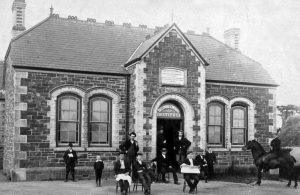 The John Passmore Edwards Reading Room (Photo: unknown – courtesy Clive Benney collection)
The John Passmore Edwards Reading Room (Photo: unknown – courtesy Clive Benney collection)
Blackwater Brass Band was formed in 1902 under Corporal C Retallack DCLI and practised in a hut near the railway line. It probably evolved from a previous reed and brass band and the photograph below shows just one remaining reed player. In my research of the history of brass bands I have not come across much information about them but can recall that their bass drum was being stored in the roof of Wards’ Garage in Blackwater during the 1950s. William Stingfell Sandoe played in an early band but as he was born in 1874 and died in 1959 we cannot be sure if it was the fife and drum or the brass band. William said of one of his birthday cakes in later life, “It’ll take so many candles that you’d better use a primus”.
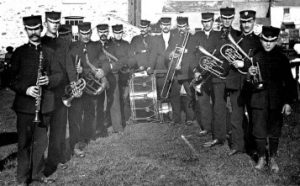 Blackwater Brass and Reed Band at Mount Hawke (Photo: unknown – courtesy Clive Benney)
Blackwater Brass and Reed Band at Mount Hawke (Photo: unknown – courtesy Clive Benney)
The non-conformist tea treat was one of the big events on the village calendar and an entry in Harrod’s Rural County Directory of Cornwall of 1878 states that in Blackwater, “A fair is held annually on Midsummer’s Day”. The children looked forward to the May Day celebrations and Olga Trewhella, a Blackwater resident, recalled the fun of dancing around the May Pole back in the early 1920s.
In 1946, Kathleen Huddy (née Osborne) interviewed Mrs Solomon of Carnhot who was 100 years of age. She said that the annual fair was attended by over two thousand people and comprised “Shows of all kinds with and fruit and sweet stalls”. Mrs Solomon went on to say that the Sunday school treat on Midsummer Day opened in glory with banners and the procession led by a brass band. The benches for the children were arranged in a circle on the green. Each child carried a cup for tea and parents dressed their children decently on these occasions and at the Sunday school anniversary. For the children there was Midsummer Eve when darkness fell and bonfires would blaze on burrows and mine dumps. As the flames rose, excited children shouted, “Midsummer Day is passing this way, A-Hip, A-Hip, A-Hurray,” before making a dash through clouds of smoke and sparks. Two fields near the Passmore Edwards Institute were often used for the event, one for the hobby-horses and side-shows and the other for games and the tea – in later years the field next to the chapel was used. Stanines (Stalls) were erected in front of the Red Lion Inn and, by night, were lit by naphtha flare lights, a forerunner of high pressure paraffin lamps. Limpets in tiny dishes were eaten with a pin and the girls were treated to trays of cherries, comfits and gingerbreads by their boy-friends.
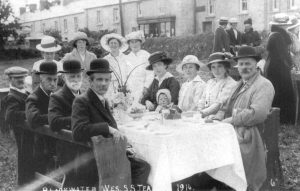 Blackwater Tea treat 1916 – John Oates with white beard (Photo: Govier)
Blackwater Tea treat 1916 – John Oates with white beard (Photo: Govier)
Such events were always preceded by a procession from the chapel to the tea treat field. They were led by one of the local bands and here the procession turned right on leaving the chapel and passed through the village until reaching the cross roads by the Red Lion Inn. From there it travelled up North Hill to the junction with the Skinners Bottom road where it did a U-turn and returned to the village. On arrival back at the Red Lion it turned right and continued out to the railway bridge (now demolished) where it turned once again and marched to the designated field. It seems that the event continued until mid-night. Tea treats were a big part of village life with the huge saffron buns, tea, games and the Serpentine walk to finish.
The Elementary Education Act of August 1870 set the framework for schooling in England and Wales for all children between the ages of five and twelve. Only a few years prior to that the state took no responsibility for schooling and those parents who wanted their children to obtain an education had to rely on the church or private arrangements. In 1864, it was reported that Perranporth, St Agnes, Baldhu, Chacewater and Mithian, a population of about 16,000, was served by eight schools teaching [only] 650 pupils(5). There were clearly many children receiving no education and, in all probability, were working on the land or down the mines. An entry in the 1871 census records that the Hawke children of Wheal Rose, aged four to twelve, were “Home, not to school”.
Mithian Church School opened on the 2nd February 1863 and Mrs Joseph Boyd of Probus was engaged as schoolmistress at a salary of £35 per year. The initial intake was ten pupils but the numbers quickly grew to over 100 with an evening school attended by 36 scholars. Together with the private and dame schools(6), the emphasis was on the three “Rs” and, particularly in the case of the Church schools, religion. The establishment of Board Schools saw a gradual flow of pupils to the state system and Mithian Church School closed in 1880.
At the bottom of Blackwater Hill, next to the old corn mill, there once stood a dame school. Women often ran such schools but in this case the tutor was James Blackney, a crippled ex-miner, who came to Blackwater in the 1840s. James taught geography, reading and writing for which he charged 2d or 3d per week depending on the pupil’s age.
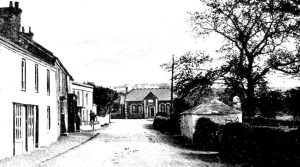 The eastward view through the village with the Passmore Edwards Reading Room in the centre (Photo: Argall – courtesy Clive Benney)
The eastward view through the village with the Passmore Edwards Reading Room in the centre (Photo: Argall – courtesy Clive Benney)
Mr C Hancock of St Agnes designed the new Blackwater School and construction commenced in 1877 by W Gilbert of Wheal Rose and J Symons of Blackwater using stone from a demolished engine house of Gump Mine. In the first school log book it states that the school opened on the 4th March 1878 with 22 children. Mr J H Oates was the first headmaster but within only a few weeks he had succumbed to a short illness and died. Hardly time enough to leave his mark on the school but his writings do tell us that when the building was first occupied, “The rooms not being quite dry have been rather cold and uncomfortable”. He goes on to say, “Most of the children coming from dame schools are very backward”. Mr Oates was succeeded by his brother, John Oates, with Miss Ellen Davies teaching the infants.
 Blackwater School prior to its enlargement in 2005 (Photo: unknown)
Blackwater School prior to its enlargement in 2005 (Photo: unknown)
An arrangement, either formal or informal, permitted children a limited period of time away from school to help with essential work in the fields. Poverty was extensive and an extra pair of working hands was always welcome. This period was invariably extended and, together with illness, bad weather and general truancy reduced the available time for learning. Truancy was a widespread problem and some parents withheld their children as a protest against the compulsory nature of education; the situation only improved after the authorities started issuing summonses.
Headmaster John Oates lived in Rock Cottage, next to the Red Lion Inn. He taught in the school for 41 years and was referred to by everyone as “Master”. A later headmaster, Richard Best, described him as, “Strict but greatly-respected”. He was very involved in the social and religious life of the community. His aesthetic legacy lives on and anyone who has travelled through the village or on the railway must have taken pleasure from the rhododendron-covered embankments of the now redundant branch line at the western end of the village – the stark areas were not particularly attractive and John Oates’ suggestion of a planting scheme was eagerly accepted. In those early days it was not necessary for teachers to be qualified in any way: they simply worked under the personal coaching of the master – pupil teachers in particular.
During the 1950s, some of the older boys took part in a competition to see who could pee furthest up the wall in the open-topped urinal stall. The boy who won should also have had the award for the unluckiest boy in the school as, in clearing the top of the wall he scored a direct hit as the headmaster, Mr Best, walked by (7).
The Chacewater to Newquay railway branch line was opened in two stages: Chacewater to Perranporth on the 6th July 1903 and the section beyond, to Newquay (Tolcarne junction), on the 2nd January 1905. The children from the various schools along its route were given a free ride on the first trip and some of the tickets have survived the 100 years since then.
 A ticket from the first journey in 1903 (Photo: unknown)
A ticket from the first journey in 1903 (Photo: unknown)
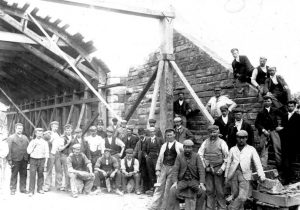 Building the Blackwater Bridge over the main A30 road (Photo: unknown – courtesy Clive Benney)
Building the Blackwater Bridge over the main A30 road (Photo: unknown – courtesy Clive Benney)
The branch left the main line a little west of Chacewater Station on a curving right hand embankment and crossed the road at the west end of Blackwater. Material from the excavations was used to form the embankment and was transported by horse-drawn wagons on temporary tracks. As the distance between the cutting and the embankment increased, a steam locomotive was used to haul the wagons until a horse was again attached for tipping. The men working on the line used picks, shovels and wheelbarrows. These were navvy barrows, quite different to the long, thin type used locally at the time. Navvy barrows were short, wide and shallow and would tip easily and their ease of use appealed to the local builders who have used them ever since.
The branch line closed in 1963 and the only remaining sign of a railway in Blackwater is John Oates’ rhododendron-covered embankment at the western end of the village. The bridge spanning the road was demolished in February 1972 in a fraction of the time it took to build; it had stood for 70 years and its removal confirmed, as if confirmation was needed, that the line would never reopen.
End notes:
- Kelly’s Directory (or more formally, the Kelly’s, Post Office and Harrod & Co Directory) was a trade directory that listed all businesses and tradespeople in a particular city or town, as well as a general directory of postal addresses of local gentry, landowners, charities, and other facilities.
- A leat is a man-made watercourse to convey water.
- “Royal Cornwall Gazette” 16th November 1905.
- ”Funding the Ladder: The Passmore Edwards Legacy” by Dean Evans (Published by Francis Boutle ISBN-13: 978-1903427668)
- “West Briton” February 1864.
- A dame school was an early form of a private elementary school in English-speaking countries. They were usually taught by women and were often located in the home of the teacher.
- Personal recollection!
A considerable amount of material in this article has been taken from Blackwater and its Neighbours by Clive Benney and Tony Mansell (Trelease Publications 0-9545583-4-0)

Tony Mansell is the author of a number of books on aspects of Cornish history. He was made a Bardh Kernow (Cornish Bard) for his writing and research, taking the name of Skrifer Istori. He has a wide interest in Cornish history and is a researcher with the Cornish National Music Archive specialising in Cornish Brass Bands and their music.

great article
Thanks Tom – and for your help
Thanks Tom
This article has brought back memories. I moved to burra burra farm, three burrows, blackwater in 1966 when I was 15. I can remember going to dances at a local church hall down the lanes from our farm.
Dad sold some of his land for the dual carriageway. I do have some photos before it was dug up. I’ve since left the area but my daughter lives in mount Ambrose. she sent me this. Very interesting..
Mum and dad are buried in mithian grave yard.
Good afternoon Tony,
Thanks for your latest story (Blackwater). I have not read it yet, I picked up the paint brush this afternoon for an hour, using acrylics. But my main reason for writing is to ask if you can pinpoint on your map the house where Passmore Edwards family lived. I have looked twice and not found it. i understand their original home has been demolished, but St Agnes OCS put a plaque of a later family home I believe. I have what is probably the most comprehensive private collection of pictures of his bequests, as I have nearly all of them. I’d go back sometime and photograph it for myself. Thanks P.
Thank you for this snapshot of Blackwater. I have the book of a Blackwater and Threeburrows . I lived at Threeburrows for many years from 1953, I went to the school when Mr Richard(Dickie) Best was the headmaster with Mrs Davis and Miss Jane.
The year I started in 1955 there were children still there aged 14 as they hadn’t passed their 11+ to go to Grammar Schools at Redruth and Truro. Shortly after Penweathers secondary Modern at Truro and Tolgus at Redruth. So the children the only stayed until they were 11.
As we had no playing field we used to join with Chacewater for a sports day on theirs.
Mr Best gave me a lifelong interest in Cornwall and it’s history, both local and further afield. Also a great pride in John Passmore Edwards the great philanthropist Mr Best wrote a small book on JPE.
Well done I am so looking forward to the next instalment. I remember so many characters
Thanks Sandra, no doubt we knew each other.
Very much enjoyed it, many thanks; it’s interesting to read about a place you
know a little of yourself.
Thanks John
Hello Tony
I very much enjoyed reading your article about the village of Blackwater. A great piece of social history. Best wishes
Andrew
Thanks Andrew
Thank you for the interesting article on Blackwater. We’ve recently moved to East Hill Farm and wondered if you or anyone else has any information about the farm and the land. I’m fascinated to learn more about its history if there is any 🙂
THanks Teri
There is a book entitles Blackwater and its Neighbours but I don’t think it offers any more information about the farm.
My family lived in Blackwater in the mid to late 19th century. My 3rd great-aunt, Rosevia Williams, was a school teacher at the school (the 1881 census says “National Schools”), but died when she was just 20 years old. Do you know if there would be records for her time there? Would the “National School” be the same as the Blackwater School?
Thank you so much for this glimpse into the town of Blackwater. My Great grandfather, Charles Henry Wicks was born there in 1865. you gave me a I have been researching info on his family for 20 years.
Great quencher for my wish to “know” my Greatgrandmother’s birthplace. I plan on crossing the pond to see it someday soon.
Fed my thirst for knowledge of my GGrandmother’s birth place. I plan on a visit someday.
My grandfather Percy Garland taught at Blackwater School in the 30’s and 40’s.
And into the 1950s, Phil.
I remember him Phil – he taught my brother but I was younger.
Blackwater became one of my favourite small village when living in Cornwall (Treamble House – Rose & Perranporth near by)
The main reason it became popular with me was my best mate Symo (John Symons) his dad was Landlord of the Red Lion Inn around 1970ish he was also a serious miner & worked in a near by mine as “shift boss” I think his proper name was Jack Symons
I still drive through Blackwater some time to keep the memories flooding back.
Blackwater is special and legendary in my Harris Family. My ancestors were miners from Blackwater, before moving to Wheal Busy, 180 years ago. Richard Harris, Toronto, Canada